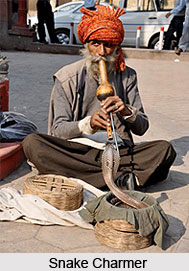 Sepalas are described as one of the most interesting group of Yogis, who trace their origin to Gorakhnath. Sepalas are also known as snake charmers. Thy go about in the cities and villages in the neighbourhood their camps, taking their snakes with them. These they charm with the music of their queer, gourd pipes (bin). One of the first things that this Gorakhnath yogis do, when any visitor reach their camp, is to show their snakes. From their flat round baskets, they take off the covers and prod the snakes with their fingers to drive them out. They capture snakes and soon after the snakes are captured they are drugged and their lungs are removed. They have large varieties of snakes. The Sepalas derive most of their income from the sale of several animals like donkeys, dogs, etc.
Sepalas are described as one of the most interesting group of Yogis, who trace their origin to Gorakhnath. Sepalas are also known as snake charmers. Thy go about in the cities and villages in the neighbourhood their camps, taking their snakes with them. These they charm with the music of their queer, gourd pipes (bin). One of the first things that this Gorakhnath yogis do, when any visitor reach their camp, is to show their snakes. From their flat round baskets, they take off the covers and prod the snakes with their fingers to drive them out. They capture snakes and soon after the snakes are captured they are drugged and their lungs are removed. They have large varieties of snakes. The Sepalas derive most of their income from the sale of several animals like donkeys, dogs, etc.
Some of the customs of the Sepalas are considered of huge interest. Like for instance, they wear in their ears very large rings. These are set the lower part of the ears, contrary to the practice of the Gorakhnathis, and the holes for the rings are made with large needle. All sorts of rings are worn, but the ones most valued are made of the bone of a certain snake found in the hills. They make offerings to Gorakhnath at the time of the piercing of the ears. These Yogis wear different sorts of beads, but especially the rudraksa, and the small white ones obtained at Hing Laj. They do not wear a sacred thread; they allow their beards to grow long, twist them in two coils and wind the ends around their ears, much as Sikhs of the Punjab do; they wear their hair in a knot and over it wind a turn in a very peculiar way, so that it looks as if it were going to topple over forward.
Sepala yogis do not practise Yoga. Like other Yogis, they bury their dead, placing the body in a sitting posture. They claim to worship Gorakhnath, and are disciples of Kanipa, or Kanipao, whose teacher was Jalandharipa. It is said, however, that Kanipa was the son of Kinwar, who caught the fish from which Matsyendranath was born. They are householders, keeping their families with them in camp. Yogis of this class seem to be included among `the criminal tribes`, who are under constant police surveillance. This particular group had evidently, earned a good reputation; for, although they had many notes from officials showing that they had been under observation in the past, they were then free to go where they pleased.
It is also claimed that Sepalas do not thieve. Their papers showed that they are great travellers and that they had been over many parts of India. Some of the gotras or family names of the Sepalas are Gadaria, Tank, Phenkra, Linak Cauhan, Tahliwal, Athwal, Sohtra and Bamna. It is also claimed that Sepalas eat snakes. These Jogis are an unclean and ignorant people despised by almost every class of Indians, but feared and dreaded by many. Sepalas are sometimes known as Kanipaos, reckoned as `halfpanth` of the Gorakhnathis. Thus, it is of huge interest to compare descriptions of the Sepalas with those of other castes of Yogis in Mumbai, Berar and the Nizam`s dominions and in the south where many hints of relationship appear.




















